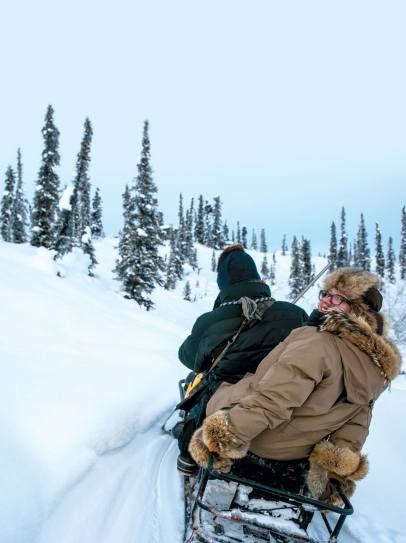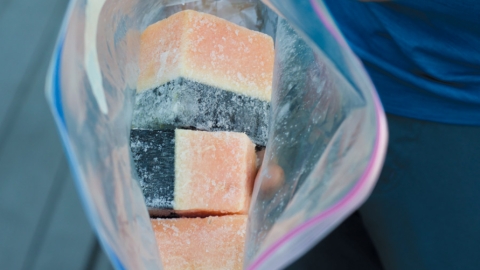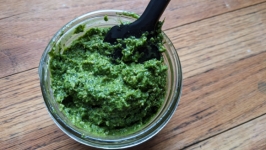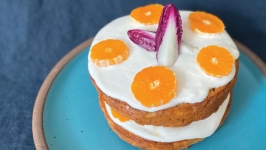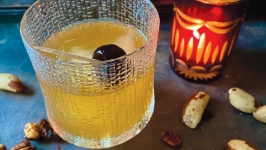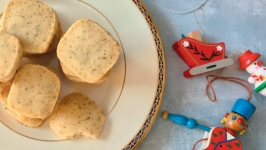The Writer & Her Book
Julia O’Malley’s Debut Collection
Back when food writer Julia O’Malley was drafting her first-ever food story about a farm-to-table dinner in Homer, a question from an editor—“What is Alaska cuisine?”—spurred five years of research and writing that would eventually become her book. Published jointly by the Anchorage Museum and University of Washington Press, The Whale & the Cupcake: Stories of Subsistence, Longing, and Community in Alaska collects pieces that O’Malley originally published in The New York Times, Anchorage Daily News, and more, including Edible Alaska, along with new interviews, recipes, and photos. It’s a book to be read and cooked from, and it belongs in home libraries as well as kitchens.
Not long after she started contemplating that fateful question, O’Malley called Kirsten Dixon (cookbook author and chef-owner at Tutka Bay and Winterlake Lodges). O’Malley repeated the question to Dixon, and recalls her saying that Alaska’s cuisine is “connected with place. It’s connected to the wild and it’s partly about subsistence, but it’s connected with the world, too, because so many people here came from elsewhere.”
No surprise, then, that O’Malley sees links between muktuk and cake mix, or between some “peach guy” selling fruit out of his trunk in an Anchorage parking lot and women in Point Hope using their hands to whip air into melted caribou fat for akutuq (often called Eskimo ice cream). She explores the deprivations of winter when produce can be hit or miss, and the successes of an urban hydroponic microgreens entrepreneur. She covers traditional whale hunting in Point Hope and “Vietnamese noodle shops… colonizing Anchorage’s strip malls.” One chapter highlights the indigenous Gwich’in Athabascans’ relationship with caribou, and another finds homemade donuts in the Aleutians.
The Whale and the Cupcake came into being alongside the Anchorage Museum’s ambitious What Why How We Eat exhibition. That show wraps up in January 2020 after a year-long run. Early in the planning stages for that exhibition, Julie Decker, Director and CEO of the Anchorage Museum, approached O’Malley about creating a food book linked to the exhibit. Chief Curator Francesca Du Brock began conceptualizing the exhibition by reading everything O’Malley had written that was under consideration for the book. In time, their conversations about themes informed both the exhibition as well as the published collection. “It felt like a godsend to be working with her on the book at the time,” Du Brock said, who also relied on the expertise of Liz Snyder, UAA professor and Co-director of the Food Research, Enterprise, and Sustainability Hub.
For a couple months or so, the book and exhibition will coexist in the world, but then the book alone will hold space for them both, serving as a de facto exhibition catalog. Du Brock is quick to observe that The Whale & the Cupcake “does not play to a completely ‘foodie’ audience. It’s about bigger issues and themes.” It does, indeed, cover Alaska’s unique foodways gamut, spanning those “two extremes of locally abundant wild foods and shelf-stable ingredients produced thousands of miles away,” as the cover copy puts it.
The related exhibition was Du Brock’s first big curatorial job at the museum, and it was not about fine art—her usual purview. Diving in, though, she realized that food is something that everyone has in common. O’Malley’s research and the stories compiled in the book foreground food against backdrops affected by climate change, colonization, gender, economics, immigration, migration, and, as Du Brock says, “cultural resilience… and all of the deepest human things—like love and connection, transience and estrangement, and all that is powerful and deep.”
Du Brock also frames O’Malley’s approach as a writer alongside artists: “for some socially engaged artists, art-making can be a pretext for having this kind of deeper interaction with people and working to address important social issues. And I think that food is very much that, for Julia, in her writing. It’s a super accessible thing where there’s not a strong hierarchy, and everybody can relate to it. And I think she uses it in a smart way to gain access to stories that might not otherwise be told.”
Decker championed the book and agrees. “The Anchorage Museum examines ideas of place through a variety of lenses and food is something that connects landscapes, lifeways, and people,” she said. “Alaska has a compelling food story, full of needs, desires, and flavors, and we are interested in the recipes of our past and future. Julia O’Malley brings forward these stories of our place through food, from cities to villages, where people make the most of what’s at hand, from what’s abundant and what’s scarce, and create a distinctly Northern approach to nourishment.”
O’Malley talks about the book as a beginning. “It would be my dream to continue the conversation in chefs’ kitchens.” She wants restaurants to follow the lead of Alaskan home cooks. She says the place where the language of Alaskan cuisine exists now is the home kitchen, which she describes as “the strongest laboratory where we repeat rituals that have to do with food, whether it’s smoking salmon, or making weeknight salmon dinner, or eating muktuk in Anchorage from the freezer… it would be cool if the restaurant kitchen could get there rather than approximating how they might eat in Seattle or how they might eat in California.” O’Malley urges Alaskan chefs to ask, “‘How do we actually eat here in our kitchens, and can we connect that up with what we are making in the restaurant kitchen?’”
The Whale & the Cupcake captures a well-timed, insightful, and inclusive take on Alaska and its food culture. The book will ring true for people at home in this culturally and geographically diverse state, and those reading it from afar will enjoy an insider view of this unique place.
Purchase The Whale & the Cupcake online or in person at the Anchorage Museum Store. anchoragemuseum.org/store


